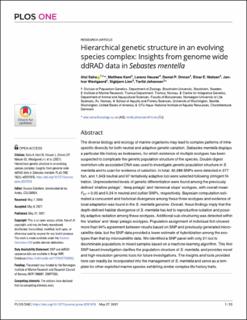| dc.description.abstract | The diverse biology and ecology of marine organisms may lead to complex patterns of intraspecific diversity for both neutral and adaptive genetic variation. Sebastes mentella displays a particular life-history as livebearers, for which existence of multiple ecotypes has been suspected to complicate the genetic population structure of the species. Double digest restriction-site associated DNA was used to investigate genetic population structure in S. mentella and to scan for evidence of selection. In total, 42,288 SNPs were detected in 277 fish, and 1,943 neutral and 97 tentatively adaptive loci were selected following stringent filtration. Unprecedented levels of genetic differentiation were found among the previously defined ‘shallow pelagic’, ‘deep pelagic’ and ‘demersal slope’ ecotypes, with overall mean FST = 0.05 and 0.24 in neutral and outlier SNPs, respectively. Bayesian computation estimated a concurrent and historical divergence among these three ecotypes and evidence of local adaptation was found in the S. mentella genome. Overall, these findings imply that the depth-defined habitat divergence of S. mentella has led to reproductive isolation and possibly adaptive radiation among these ecotypes. Additional sub-structuring was detected within the ‘shallow’ and ‘deep’ pelagic ecotypes. Population assignment of individual fish showed more than 94% agreement between results based on SNP and previously generated microsatellite data, but the SNP data provided a lower estimate of hybridization among the ecotypes than that by microsatellite data. We identified a SNP panel with only 21 loci to discriminate populations in mixed samples based on a machine-learning algorithm. This first SNP based investigation clarifies the population structure of S. mentella, and provides novel and high-resolution genomic tools for future investigations. The insights and tools provided here can readily be incorporated into the management of S. mentella and serve as a template for other exploited marine species exhibiting similar complex life history traits. | en_US |
